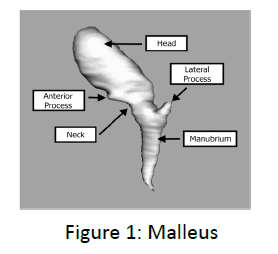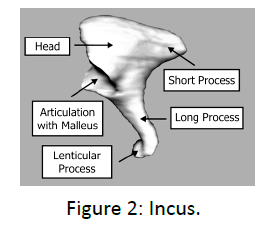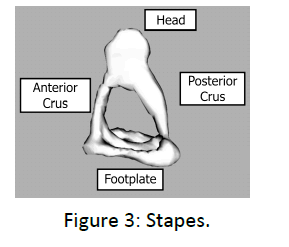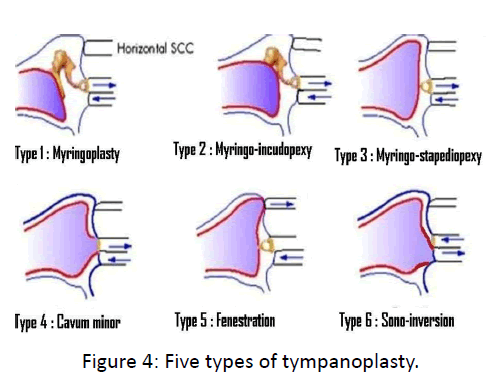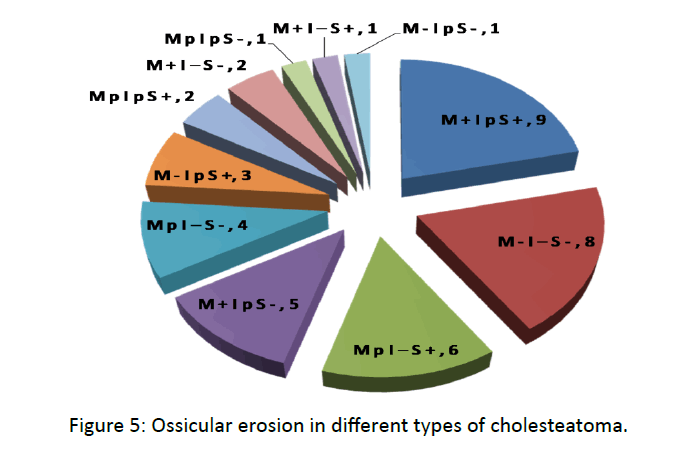Research Article - Otolaryngology Online Journal (2017) Volume 7, Issue 1
New Classification of Ossicular Status and Study In Patients with Ossicular Erosion to be Used for Ossiculoplasty
- *Corresponding Author:
- Thamizh arasan, M.B.B.S.,D.L.O.,M.S.(ENT) Govt. Royapettah Hospital, Kilpauk Medical College, Chennai, Tamilnadu, India, Tel: +919840273799, E-mail: thamizhent06@gmail.com
Received date: September 14, 2016; Accepted date: February 20, 2017; Published date: February 27, 2017
Abstract
To analyze the nature of ossicular erosion and classify the remnant ossicles to be used for ossiculoplasty. Patients between 12 and 60 years of age with a history of ear discharge with moderate conductive deafness (>40 dB HL) were included in the study. The patients were assessed of ossicular erosion by new classification of ossicular status which included remnant ossicles (M=Malleus, I=Incus, S=stapes, + =present, - =absent, p=partially eroded). Out of 42 cases studied, Incus is always eroded partially or completely in equal cases. Suprastructure of stapes is next common to be eroded in nearly 75% of cases. Malleus was undisturbed in 50% of cases. Malleus handle was the least part to get eroded. New classification of ossicular status is needed for in cases undergoing ossiculoplasty for documentation and better representation of disease process.
Keywords
Ossicular erosion, Malleus, Incus, Stapes
Introduction
Evolution of hearing mechanism from invertebrates to mammals
Invertebrates do not have ears. But they can detect sound using other kinds of sense organs. Insects have tympanal organs situated on the side of head [1] or along the body or legs to perceive distant sounds [2]. Fish perceive sounds with the help of lateral lines that are present in the side of their bodies [3]. Amphibians have no external ears. But the middle ear is developed. It has an ear drum on the side of head like a disc of cartilage. To the inside of this ear drum a thin rod of cartilage and bone (ossicle) known as columella passes in an air filled cavity (middle ear) upto the inner ear. The columella terminates as an expansion like the stapes which is in relation to oval window. In reptiles the tympanic membrane is bulging out alongside the jaw bones quadrate and articular. The membrane is again connected to inner ear by a single bone, stapes. In birds the middle ear consists of two bones an osseous inner part, columella and a cartilaginous extra columella that is in contact with tympanic membrane.
Over the course of transition from reptiles to mammals [4], one lower and one upper jaw bone (the articular and quadrate) become of no use in the jaw and migrated to the middle ear, connecting to the stapes and forming a chain of three bones (collectively called the ossicles) which amplify sounds and allow more accurate hearing. In mammals, these three bones are known as malleus, incus, and stapes (hammer, anvil, and stirrup respectively). While the stapes is present in many types of tetrapods, the addition of the incus and malleus in the middle ear is a unique feature of mammals, distinguishing them from other vertebrates.
Ossicles in Human Beings
There are 3 ossicles in the middle ear which conducts sound from external ear to inner ear. They are Malleus, Incus and Stapes. Malleus (Figure 1) is the lateral and largest of the ossicles. It is about 8 to 9 mm long. It has following parts; Head is rounded and lies in the attic, articulates posteriorly with the body of incus and gives attachment to superior and lateral malleolar ligaments. Neck lies against the pars flaccida and related medially to Chorda tympani. Anterior process is connected to the petro tympanic fissure by the anterior malleolar ligament. Lateral process projects from upper end of the handle and provides attachment to the malleolar folds. Handle extends downwards, backwards and medially and it is attached to upper half of the tympanic membrane. Incus (Figure 2) parts of incus are Body which is large with its articular surface directing forwards, short process which is directed backwards and is fixed to fossa incudis just below the aditus and Long process which is directed downwards into the cavity just behind and parallel with the handle of malleus. Its tip bears a lentiform process which is directed medially to get articulated with stapes head. Stapes (Figure 3) is the medial most and smallest of the 3 ossicles. It has following parts; Head has a small concave facet which articulates with lentiform nodule. Neck is the narrowest part giving insertion to tendon of stapedius. Crura are two in number, the anterior and posterior one. The anterior crura is shorter and less curved. The limb diverges from neck and gets attached to the foot plate. Foot plate is oval in shape and fits into the oval window
Essential of middle ear ossicles for hearing
The human middle ear transforms the low impedance sound energy in the external auditory canal through the tympanic membrane and ossicles to a high impedance of perilymph inside oval window [5].
The sound transmitting mechanism of middle ear is classified as three systems
1. Catenary lever-by tympanic membrane
2. Ossicular lever-by auditory ossicles
3. Hydraulic lever-by the difference between tympanic membrane and the stapes foot plate.
Catenary Lever
The tympanic membrane is rigidly attached to annulus. This cause increase in energy at handle of Malleus because of the middle fibrous layer of tympanic membrane. Since the annulus is fixed the sound energy runs from periphery to centre and thereby handle of Malleus perceives the sound.
Ossicular Lever
The Malleus incus assembly moves together thereby causing a gain of 1.3:1 because of difference in length of manubrium of Malleus and long process of incus. Both levers, Ossicular and catenary gives a ratio of 1:2.3.
Hydraulic Lever
The sound conducted from a large tympanic membrane to small foot plate gives a increase force at the level of foot plate. The total ratio is 20.8:1. Ossicular, catenary and hydraulic lever gives a sound gain of 34 decibels.
Ossicular Coupling
It is the real gain in pressure of sound while sound travels from tympanic membrane through the ossicles. It depends on frequency and not 34decibels always. It is 20 decibels in 250 to 500hz and 25 decibels in 1000hz then decreases to 6decibels for every octave thereafter. This is because in higher frequencies the tympanic membrane vibrates at different portions. Also the Ossicular chain slips at higher frequencies.
Acoustic coupling
The sound conducted hits oval and round window and normally there is nothing much appreciated.
In case of operated ears the difference may be significant enough to cause hearing loss.
Stapes Cochlear Input Impedance
This indicates the factors causing impairement of movement of foot plate of stapes into oval window thereby increasing the impedance and hearing loss.
Causes for Ossicular Pathology
Ossicles may be either fixed or in discontinuity
The Causes of Ossicular Fixation are:
1. Malleus head ankylosis. The reason for ankylosis is idiopathic [6].
2. Ossicular tympanosclerosis secondary to healing following perforations
3. Scar bands following chronic otitis media.
The Causes for Ossicular Discontinuity are:
1. Trauma
2. Erosion by chronic otitis media and cholesteatoma
The most common ossicles eroded in order of frequency are:
1. Eroded incudostapedial joint. Lenticular process of incus is commonly eroded.
2. Absent incus
3. Absent incus and stapes superstructure
4. Erosion of head of Malleus
5. Handle of Malleus is the least common part to erode following cholesteatoma.
Mechanism of Ossicular Erosion
The proposed mechanism for erosion is chronic middle ear inflammation following increased production of cytokines—TNF alpha, interleukin-2, fibroblast growth factor, and platelet derived growth factor. They all produce hypervascularisation, osteoclast activation and bone resorption which leads to ossicular damage. TNF-alpha also produces neovascularisation and hence granulation tissue formation.
Methods for Assessing Ossicular Pathology
Clinical examination includes otoscopic examination or under microscope looking for any congenital abnormality and examining external auditory canal and Status of the tympanic membrane and middle ear if seen. CT scan of temporal bone will give the Extent of middle ear pathology (cholesteatoma), Tympanic cavity, Ossicular chain status, Malleus fixity,
Otosclerosis
and Inner ear anatomy. Ossicular discontinuity is suspected when the patient has conductive hearing loss more than 50dB in Pure Tone Audiogram.
Available classifications for ossicular status
Austin in 1972 defined four groups of Ossicular status [7]
malleus handle present, stapes superstructure present (60%) M+ S+
malleus handle present, stapes superstructure absent (23%) M+ S-
malleus handle absent, stapes superstructure present (8%) M- S+
malleus handle absent, stapes superstructure absent (8%) M- S
Kartush in 1994 described a scoring system (Table 1) to find the success probability, MERI (Middle ear risk index) [8].
| Risk Factor | Risk value |
|---|---|
| Otorrhoea | |
| Dry | 0 |
| Occassionally wet | 1 |
| Persistantly wet | 2 |
| Wet, cleft palate | 3 |
| Perforation | |
| Absent | 0 |
| Present | 1 |
| Cholesteatorna | |
| O: M + I + S + | 0 |
| A: M + S + | 1 |
| B: M + S - | 2 |
| C: M- S + | 3 |
| D: M- S - | 4 |
| E: Ossicle Head fixation | 2 |
| F: Stapes fixation | 3 |
| Middle ear: granulation or effusion | |
| No | |
| Yes | |
| Previous surgery | |
| None | 0 |
| Staged | 1 |
| Revision | 2 |
Table 1: Middle ear risk index (MERI) scores
Dornhoffer designed the Ossicular Outcomes Parameters (Table 2) Staging (OOPS) [9].
| Risk factor | Risk value |
|---|---|
| Middle ear factors | |
| Drianage | |
| None | 0 |
| Present > 50% of time | 1 |
| Mucosa | |
| Normal | 0 |
| Fibrotic | 2 |
| Ossicles | |
| Normal | 0 |
| Malleus + | 1 |
| Malleus - | 2 |
| Surgical factors | |
| Type of surgery | |
| No mastoidectomy | 0 |
| Canal-wall-up mastoidectomy | 1 |
| Canal-wall-down mastoidectomy | 2 |
| Rrevision surgery | |
| No | 0 |
| Yes | 2 |
Table 2: Ossiculoplasty outcome parameter staging index
Ugo Fisch classification of Ossicular defects (Table 3) with hearing outcomes [10]
| ABG | Preop status of ossicles and mastoid |
|---|---|
| <10dB | Malleus: Handle intact Incus: Absent Stapes: Intact |
| <20dB | Malleus: Handle intact Incus: Absent Stapes: Fixed /no superstructure |
| <30dB | Open/closed cavity mastoidectomy Malleus: Absent Incus: Absent Stapes: Mobile/fixed/mobile footplate |
Table 3: Ugo fisch classification of ossicular status
Zoellner and Horst Ludwig Wullstein, H. mentioned five types of Tympanoplasty (Figure 4) depending upon the ossicular status [11]
New classification of ossicular status
Malleus: M + =Malleus completely present (Table 4).
| M + I + S + | M + I + S - |
| M + I p S + | M + I p S - |
| M + I – S + | M + I – S - |
| M p I + S + | M p I + S - |
| M p I p S + | M p I p S - |
| M p I – S + | M p I – S - |
| M - I + S + | M - I + S - |
| M - I p S + | M - I p S - |
| M - I – S + | M - I – S - |
Table 4: Proposed new classification
M p =Malleus partially eroded less than 50% (remnant 50 – 99 %) or level to which it can be used for ossicular reconstruction
M - =Malleus eroded more than 50% (remnant 0 – 49 %) or level to which it cannot be used for ossicular reconstruction
Incus
I + =Incus completely present
I p =Incus partially eroded less than 50% (remnant 50 – 99 %) or level to which it can be used for ossicular reconstruction
I - =Incus eroded more than 50% (remnant 0 – 49 %) or level to which it cannot be used for ossicular reconstruction
Stapes
Stapes suprastructure alone is taken into account
S + =Stapes suprastructure completely present
S p =Stapes one crura eroded (very rare situation).
S - =Stapes suprastructure completely eroded
Important note to the new classification
1. Percentage erosion of ossicles is an arbitrary assessment with observer variation. Kindly correlate with anatomy described above.
2. S p can be excluded if needed since partial erosion of suprastructure of stapes (Sp) is rare. Single crura will be inadequate for reconstruction and it mostly needs ossiculoplasty in other forms. Hence we have not included S p in our new classification (Table 5).
| S.No | Age / sex | Diagnosis | Ossicular status |
|---|---|---|---|
| 1 | 32/M | B/L CSOM with PSRP | M- I- S- |
| 2 | 23/F | Right CSOM with extensive granulation | M+ I- S- |
| 3 | 48/F | Left traumatic ossicular discontinuity | M+ Ip S+ |
| 4 | 14/F | Right PSRP with cholesteatoma | M+ Ip S+ |
| 5 | 27/M | Right attic cholesteatoma | Mp I- S+ |
| 6 | 71/M | Left CSOM with total perforation with facial paralysis | M- I- S- |
| 7 | 23/M | Right attic cholesteatoma | Mp I- S+ |
| 8 | 42/M | Right CSOM with extensive granulation | M- I- S- |
| 9 | 42/F | Left attic cholesteatoma | M- Ip S+ |
| 10 | 18/M | Right PSRP with cholesteatoma | M+ Ip S- |
| 11 | 27/M | Right CSOM with extensive granulation | M+ Ip S- |
| 12 | 15/F | Right CSOM with extensive granulation | Mp I- S- |
| 13 | 38/M | Left attic cholesteatoma | M- I- S- |
| 14 | 41/M | Right PSRP with cholesteatoma | M+ Ip S- |
| 15 | 33/F | Left CSOM with dry central perforation | M+ Ip S+ |
| 16 | 31/M | Left attic cholesteatoma | M+ Ip S+ |
| 17 | 15/M | Right attic cholesteatoma | Mp I- S+ |
| 18 | 16/F | Right CSOM with extensive granulation | M+ Ip S+ |
| 19 | 35/M | Right PSRP with cholesteatoma | Mp I- S- |
| 20 | 23/F | Left attic cholesteatoma | M- Ip S+ |
| 21 | 36/F | B/L attic cholesteatoma | M- I- S- |
| 22 | 56/F | Right cholesteatoma with auto cavity | M+ Ip S- |
| 23 | 14/M | Right cholesteatoma with auto cavity | M- I- S- |
| 24 | 41/F | Right attic cholesteatoma | Mp I- S+ |
| 25 | 13/M | Left CSOM with PSRP | M+ Ip S- |
| 26 | 15/M | Right attic cholesteatoma | M+ I- S+ |
| 27 | 30/F | Left attic cholesteatoma | M- Ip S+ |
| 28 | 25/F | Left PSRP with cholesteatoma | M+ Ip S+ |
| 29 | 35/M | Left attic cholesteatoma | M- Ip S- |
| 30 | 17/M | B/L attic cholesteatoma | M- I- S- |
| 31 | 27/M | Left adhesive otitis media | Mp Ip S- |
| 32 | 21/M | B/L CSOM with granulation | M+ Ip S+ |
| 33 | 18/F | Right PSRP with cholesteatoma | M+ Ip S+ |
| 34 | 27/M | Left CSOM with granulation | M+ Ip S+ |
| 35 | 18/M | Left CSOM with dry CP with scutum erosion | Mp Ip S+ |
| 36 | 43/F | Right post MRM residual perforation | M- I- S- |
| 37 | 18/F | B/L CSOM with PSRP | M+ I- S- |
| 38 | 42/f | Left CSOM with granulation | Mp Ip S+ |
| 39 | 29/M | Left attic cholesteatoma | Mp I- S- |
| 40 | 12/F | Left attic cholesteatoma with facial paralysis with Labyrynthitis | Mp I- S- |
| 41 | 35/M | Left attic cholesteatoma | Mp Ip S- |
| 42 | 45/F | Left attic cholesteatoma | Mp I- S+ |
M – MALLEUS I – INCUS S – STAPES + - PRESENT p – PARTIAL EROSION - - ABSENT
CSOM- chronic suppurative otitis media
MRM – Modified radical mastoidectomy
PSRP- posterosuperior retraction pocket
Table 5: Total cases with Ossicular Pathology
Proposed New Classification
Specific factors for new classification of ossicular status which were not present in previous classifications are the following:
1. Remnant ossicles or partial erosion of ossicles is the problem and solution for ossiculoplasty. Interposition of remnant ossicles autologous is safe and cost effective.
2. Remnant ossicle (partial erosion denoted as p in our classification) indicates in detail about extent of disease and whether remnant ossicle was there available for ossiculoplasty for documentation and future study purposes.
3. Previous classifications have not included INCUS. Incus (long process) is the most common ossicle eroded. Remaining body and short process of incus is commonly used for ossiculoplasty.
4. Malleus head is another ideal ossicle for reconstruction.
5. Stapes suprastructure presence or absence indicates PORP or TORP when artificial prosthesis is used
Aims of Study
• To analyze the nature of ossicular erosion and classify the remnant ossicles to be used for ossiculoplasty.
• Patients between 12 and 60 years of age with ossicular pathology undergoing surgery were included in the study.
• Pre-operative evaluation with high resolution CT temporal bone and pure tone audiogram was done.
• The patients were assessed of ossicular erosion noted intra operatively by new classification (NEW classification of ossicular status) which included remnant ossicles (M =malleus, I =Incus, S =stapes, + =present, - =absent, p =partially eroded).
Results/Observations
Individual ossicular status noted in patients with ossicular erosion Table 6.
| Malleus | Total | Incus | Total | Stapes | Total | |||
|---|---|---|---|---|---|---|---|---|
| N | % | N | % | N | % | |||
| Present | 20 | 47.6 | Present | 0 | 0 | Present | 12 | 28.6 |
| Partial erosion | 10 | 23.8 | Partial erosion | 22 | 52.4 | |||
| Absent | 12 | 28.6 | Absent | 20 | 47.6 | Absent | 30 | 71.4 |
| Total | 42 | 100.0 | Total | 42 | 100.0 | Total | 42 | 100.0 |
Table 6: Individual ossicular status noted in patients with ossicular erosion
Applying New classification of ossicular status showing patterns of ossicular erosion Table 7.
| New classification of ossicular status | No. of cases | Description |
|---|---|---|
| M + I p S + | 9 | Only long process of incus eroded |
| M - I – S - | 8 | All ossicles eroded |
| M p I – S + | 6 | Entire incus with part of malleus eroded |
| M + I p S - | 5 | Long process of incus and suprastructure eroded |
| M p I – S - | 4 | Part of malleus, entire incus and suprastructure |
| M - I p S + | 3 | Entire malleus and body of incus eroded |
| M p I p S + | 2 | Part of malleus and body of incus eroded |
| M + I – S - | 2 | Entire incus and suprastructure eroded |
| M p I p S - | 1 | Long process of incus and Suprastructure of stapes eroded |
| M + I – S + | 1 | Only Incus completely eroded |
| M - I p S - | 1 | Entire malleus, suprastructure of stapes was eroded along with long process of incus |
| N = 42 | ||
Table 7: Applying New classification of ossicular status showing patterns of ossicular erosion
Discussion
Incus is always eroded partially (most commonly long process) or completely more or less in equal no. of cases. Suprastructure of stapes is next common to be eroded in nearly 75% of cases. Malleus was undisturbed in 50% of cases. Malleus handle was the least part to get eroded. Preoperative assessment with CT temporal bone could not predict ossicular status accurately and our study is not intended to correlate CT findings with intraoperative findings.
Applying new classification of ossicular status, M + I p S + was common indicating early disease with involvement of only long process of incus. M - I – S – was next common type indicating advanced disease where all ossicles were eroded (Figure 5). The average pure tone average in audiogram in patients with ossicular erosion was 55.33 dB. In patients where all the ossicles were eroded completely (M-I-S-) the pure tone average in audiogram ranged from 48 dB to 90 dB. The lesser hearing loss preoperatively noted in some cases may be attributed to bridging cholesteatoma. In patients with minor ossicular erosion (M+IpS+, M+I+S-) the pure tone average in audiogram ranged from 36 dB to 75 dB. Our study could not correlate preoperative audiogram assessment with ossicular status consistently. May be a larger case series could exhibit patterns of audiogram in specific ossicular erosion.
The other main advantage of our new classification explain set pattern of ossicular erosion in different types of cholesteatoma. In Posterior mesotympanic cholesteatoma the first ossicle eroded shall be lenticular process, long process and suprastructure of stapes. In Posterior epitympanic cholesteatoma the body of incus is eroded first, then long process, head of malleus. In Anterior epitympanic cholesteatoma malleus will be involved first.
Review of Literature
Ossicular chain status in chronic suppurative otitis media in adults [12]. In this study they studied a total of 150 patients of CSOM to assess the intra-operative ossicular status. The ossicular chain was found intact (M+I+S+) in 92 (61.34%) cases. In safe CSOM, 83 cases (92.22%) had an intact chain, 7 cases (7.77%) had ossicular damage. In unsafe CSOM, intact malleus with eroded incus and stapes (M+S−) was seen in 16 (26.67%) cases, followed by M−S− in 15 cases (25.00%). In this study they found the malleus to be the most resistant ossicle to erosion in chronic suppurative otitis media whereas incus was found to be the most susceptible.
Ossicular chain erosion in chronic suppurative otitis media [13] Doha, Qatar. 279 ears that underwent surgery for chronic otitis media were studied and their ossicular status was reported. Ossicular chain was eroded in 66 (23.66%) out of the 279 ears. Erosion was more frequent in cholesteatoma ears (69.3%) than in safe ears (13.9%). The most frequently impaired ossicle was the incus and was found eroded in 62 (22.2%) ears. Malleus was found to be the most resilient ossicle and was eroded only in 13 (4.7%) ears. The stapes was eroded in 31 (11.1%) ears.
Ossicular Chain Status in Chronic Suppurative Otitis Media [14] E.N.T, Gauhati Medical College. Total of 167 patients were included in this study out of 99,208 patients attending ENT OPD in tertiary care institute during the two years study period. The malleus was found to be the most resistant ossicle to erosion in CSOM. The malleus was found intact in 63 (37.33%) and eroded in 25 (15.33%) and absent in 79 (67.33) cases. The handle of malleus in 19 (11.37%) cases, was the most commonly necrosed part of malleus. Incus was the ossicle most commonly found eroded in our study. Incus was observed to be the most common ossicle to get necrosed in cases of CSOM. In our study, incus was found intact in 47 (28.14%) cases, eroded in 16 (9.58%) cases and absent in 104 (62.27%) cases. stapes was found intact in 56 (33.35%) cases while in 111 (66.46%) the superstructure of stapes was found eroded by the disease. the footplate was found intact in all cases. The malleo-incudal joint was found intact in 88 (52.69%) and discontinuous in 79 (47.30%) cases. The incudo-stapedial joint was found intact only in 47 (28.14%) cases and discontinuous in 120 (71.85%) the ossicular chain was found intact (m+I+s+) in 47 cases. intact malleus with eroded incus and stapes was seen in 9 cases. all ossicles were absent except stapes superstructure in 79 cases.
Intra operative ossicular status [15] in CSOM PIMS, Karimnagar, Telangana 150 patients of CSOM were selected and were subjected for clinical examination, pure tone audiometry and CT scan of temporal bone. Incus is the most commonly affected oscicle while malleus is the least affected.
Ossicular status in cholesteatoma: a departmental experience in a state medical college of westbengal [16]. 60 cases of cholesteama, Ossicles and their parts getting involved in cholesteatoma cases, in decreasing order are : lenticular process (in total 50 cases)>long process of incus (in total 49 cases) > stapes super-structure(in total 29 cases) > body of incus(in total 26 cases)> head of malleus(in total 23 cases)> handle of malleus(in total 10 cases). Ossicular chain defeact in decreasing order are : m-i-s- > m+i-s- > m-i-s+ > m+i-s+. In their study it was found that incus is the most vulnerable ossicle to get involved in cases of active squamosal variety of chronic otitis media whereas malleus appeared to be the least susceptible one.
Infection and Ossicular necrosis in atticoantral disease [17] Bhaskar Medical College, Yenkapally, Moinabad, during surgery it was observed that 17 patients (34%) of the patients had only incus necrosed, 16 patients (32%) of patients had both incus and malleus involved. All the 3 ossicles were involved in 5 patients (10%) of patients. 11 pateints (22%) had intact ossicular chain. There was only 1 case (2%) where only malleus was involved while no case of only stapes involvement was noted.
Our observation correlates with the studies reviewed above in terms of common ossicles involved (Table 6).
Conclusion
New classification of ossicular status is needed for in cases undergoing ossiculoplasty for documentation and better representation of disease process. Previous classifications have not included incus. Remnant ossicles or partial erosion of ossicles is the problem and solution for ossiculoplasty. Remnant ossicle (partial erosion denoted as p in our classification) indicates in detail about extent of disease and whether remnant ossicle was there available for ossiculoplasty for documentation and future study purposes. Stapes suprastructure presence or absence indicates PORP or TORP when artificial prosthesis is used.
References
- Scott-Brown’s Otorhinolaryngology, head and neck surgery 7th edition pp: 966.
- Yack, JE and JH Fullard (1993) What is an insect ear? Ann. Entomol. Soc Am. 86: 677-682.
- Platt ANC (1993) "Inner ear and lateral line". The Physiology of Fishes (CRC Press) (1st edn).
- Allin EF (1975) Evolution of the mammalian middle ear. J. Morphol 147: 403–437.
- Scott-Brown's Otorhinolaryngology: Head and Neck Surgery. (7 Edn) 3:3179-3183
- Scott-Brown's Otorhinolaryngology: Head and Neck Surgery. (7 Edn) 1: 954.
- Austin DF (1972) Ossicular reconstruction. Otolaryngol Clin North Am 5: 689-714.
- Kartush JM (1994) Ossicular chain reconstruction: capitulum to malleus. Otolaryngol Clin North Am 27: 689-715.
- Dornhoffer JL (2001) Prognostic factors in ossiculoplasty: a statistical staging system Otol Neurotol 22: 299-304.
- Fisch U, May J (1994) Scott-Brown's Otorhinolaryngology: Head and Neck Surgery. (7th edn) New York: Thieme.
- Wullstein H (1956) Theory and practice of tympanoplasty. Laryngoscope 66: 1076–1093.
- Saurabh Varshney, Ashutosh Nangia , Bist SS, Singh RK, Gupta N, et al. (2010) Ossicular Chain Status in Chronic Suppurative Otitis Media in Adults. Indian J Otolaryngol Head Neck Surg 62: 421–426.
- Hassan Haidar, Rashid Sheikh, Aisha Larem, Ali Elsaadi, Hassanin Abdulkarim, et al. (2015) Ossicular Chain Erosion in Chronic Suppurative Otitis Media. Otolaryngology: Open Access 5:4.
- Gautam Kumar Nayak, Daizy Barhma, Pritam Chatterjee, Priyam Sharma (2016) Ossicular Chain Status in Chronic Suppurative Otitis Media. IOSR Journal of Dental and Medical Sciences (IOSR-JDMS) 15: 20-23.
- Hanumantha Rao AVS, Ramesh G, Nandini S (2016) Global Journal For Research Analysis Vol: 5.
- Somesh Mozumder, Arunabha Sengupta, Alok Ranjan Sondal, Soumik Basu Bjorl (2015) ossicular status in cholesteatoma : a departmental experience in a state medical college of WestBengal. Bengaluru Journal of otolaryngology and Head Neck Surgery 23.
- Vijay kumar R,Naveen kumar K, Radha Krishna N, Indira S, Ramakrishnaiah P (2015) Infection and Ossicular necrosis in atticoantral disease. Jorl Vol: 5.
